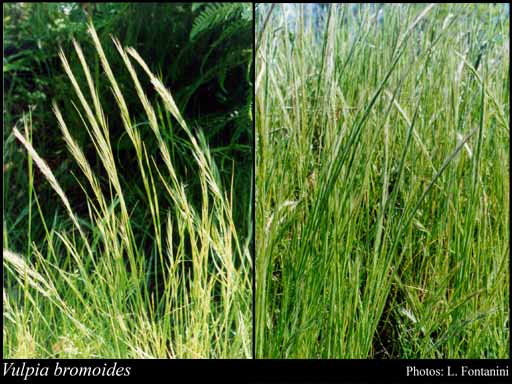- Reference
- Nat.Arr.Brit.Pl. 2:124 (1821)
- Conservation Code
- Not threatened
- Naturalised Status
- Alien to Western Australia
- Name Status
- Current
Loosely tufted annual, grass-like or herb, 0.05-0.6 m high. Fl. green, Sep to Dec. Sandy loam, sand.

Distribution
- IBRA Regions
- Avon Wheatbelt, Coolgardie, Esperance Plains, Geraldton Sandplains, Jarrah Forest, Mallee, Swan Coastal Plain, Warren.
- IBRA Subregions
- Fitzgerald, Katanning, Lesueur Sandplain, Merredin, Northern Jarrah Forest, Perth, Southern Cross, Southern Jarrah Forest, Warren, Western Mallee.
- Local Government Areas (LGAs)
- Albany, Armadale, Bayswater, Belmont, Beverley, Boyup Brook, Bridgetown-Greenbushes, Bruce Rock, Bunbury, Busselton, Canning, Coolgardie, Cranbrook, Dandaragan, Dardanup, Gingin, Goomalling, Gosnells, Harvey, Kalamunda, Kojonup, Kondinin, Kwinana, Manjimup, Mundaring, Nannup, Northam, Perenjori, Plantagenet, Ravensthorpe, Serpentine-Jarrahdale, Stirling, Swan, Toodyay, Waroona, West Arthur.
Management Notes (for the Swan NRM Region)
Alternative Names. Silvergrass, brome fescue.
General Biology. Growth form. Grass. Life form. Annual, caespitose. Reproduction. Seed. Dispersal. Mammals (on fur), water, human activities. Photosynthetic Pathway. C3. Seedbank persistence. Possibly 1-5 years. Fire response. Killed by fire.
Notes. Prevalent weed of grasslands in temperate climates that can negatively impact on ecosystem functions. Responds positively to soil phosphorous. Resistant to Group A or fops herbicides, including fluazifop-butyl (Fusilade® Forte) and Targa®.
Additional information. Origin. Africa, temperate Asia, Europe. History of use/introduction. Seed contaminant. Similar exotic species. Vulpia myuros.
Suggested method of management and control. Prevent seed set. Hand pull plants or spray with Select® 10 ml/10 L (500 ml/ha) prior to boot stage. It is important to minimise bare ground through autumn and winter to suppress annual weed population growth. Read the manufacturers' labels and material safety data sheets before using herbicides. For further information consult the Australian Pesticides and Veterinary Medicines Authority to determine the status of permits for your situation or state.
Management Calendar
| Calendar Type | Jan | Feb | Mar | Apr | May | Jun | Jul | Aug | Sep | Oct | Nov | Dec | Comments |
|---|---|---|---|---|---|---|---|---|---|---|---|---|---|
| Active Growth | Y | Y | Y | Y | Y | Y | |||||||
| Germination | O | Y | O | ||||||||||
| Flowering | Y | Y | Y | ||||||||||
| Fruiting | U | U | |||||||||||
| Optimum Treatment | Y | Y | O |
Legend: Y = Yes, regularly, O = Occasionally, U = Uncertain, referred by others but not confirmed.
References
- Allcock, K.G. (2002) Effects of phosphorous on growth and competitive interactions of native and introduced species found in White Box woodlands. Austral Ecology, 27: 638-646.
- Anon. (2009) Group D/22 Resistant Silvergrass (Vulpia bromoides). WeedScience.org URL: http://www.weedscience.org/Case/Case.asp?ResistID=17 - Accessed February 2010.
- Brown, K. & Brooks, K. (2002) Bushland Weeds: A Practical Guide to their Management. Environmental Weeds Action Network, Greenwood.
- Brusati, E. & DiTomaso, J. (2003) Plant Assesment Form: Vulpia bromoides. California Exotic Pest Management Council and the Southwest Vegetation Management Association, California.
- Code, G.R. (1996) Why vulpia is a problem in Australian agriculture. Plant Protection Quarterly, 11 (1): 202-204.
- Department of Primary Industries (2009) Squirrel-tail Fescue (Vulpia bromoides). State of Victoria URL: http://www.dpi.vic.gov.au/dpi/vro/vrosite.nsf/pages/weeds_grasses_squirell_tail_fescue - Accessed February 2010.
- Dillon, S.P. & Forcella, F. (1984) Germination, emergence, vegetative growth and flowering of two silvergrasses, Vulpia bromoides (l.) S.F. Gray and V. myuros (L.) C.C. Gmel. Australian Journal of Botany, 32: 165-175.
- Dowling, P.M., Leys, A.R., Verbeek, B., Millar, G.D., Lemerle, D. & Nicol, H.I. (2004) Effect of annual pasture compostion, plant density, soil fertility and drought on vulpia (Vulpia bromoides (L.) S.F. Gray). A,.
- Hussey, B.M.J., Keighery, G.J., Dodd, J., Lloyd, S.G. & Cousens, R.D. (2007) Western Weeds. A guide to the weeds of Western Australia. 2nd Edition. The Plant Protection Society of Western Australia, Victoria Park.
- Lonsdale, W.M., Dowling, P.M. & Vitou, J. (1999) Population dynamics of Vulpia in exotic and native ranges. In 12th Australian Weeds Conference, Papers and Proceedings, Hobart, Tasmania, Australia, 12-16 September 1999: Weed management into the 21st century: do we know where we're going?.389-391.
- Moore, J.H. & Wheeler, J. (2008) Southern weeds and their control. DAFWA Bulletin 4744.
- Mount Annan Botanic Garden (Undated) Vulpia bromoides. URL: http://www.rbgsyd.nsw.gov.au/science/Research/Ecology_of_Cumberland_Plain_Woodland/woodland_plants/vulpia_bromoides - Accessed February 2010.
- Tozer, K.N., Chapman, D.F., Cousens, R.D., Quigley, P.E., Dowling, P.M., Kearney, G.A. & Cameron, C.A. (2009) Effects of perennial species on the demography of annual grass weeds in pastures subject to seasonal drought and grazing. Crop and Pasture Science, 60: 1088-1096.
- Tozer, K.N., Chapman, D.F., Quigley, P.E., Dowling, P.M., Cousens, R.D. & Kearney, G.A. (2008) Effect of grazing, gap dynamics & inter-specific seedling competition on growth and survival of Vulpia spp. and Hordeum murinum spp. leporinum. Australian Journal of Agricultural Research, 59: 646-655.
- Tozer, K.N., Chapman, D.F., Quigley, P.E., Dowling, P.M., Cousens, R.D. & Kearney, G.A. (2009) Integrated management of vulpia in dryland perennial pastures of southern Australia. Crop and Pasture Science, 60: 32-42.
- USDA, ARS, National Genetic Resources Program (2009) Germplasm Resources Information Network - (GRIN). National Germplasm Resources Laboratory, Beltsville, Maryland. URL: https://npgsweb.ars-grin.gov/gringlobal/taxon/taxonomysimple.aspx - Accessed October 2009.
- Wallace, A. (1997) The biology of Australian Weeds. 30. Vulpia bromoides ((L.) S.F. Gray) and V. myuros ((L.) C.C. Gmelin). Plant Protection Quarterly, 12 (1): 18-28.